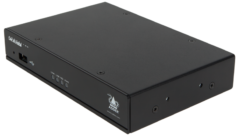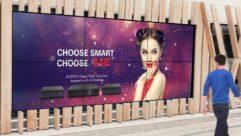
Inside the HDBaseT Standard, Part 2
Aug 16, 2012 12:04 PM,
With Bennett Liles
Listen to the Podcasts
Editor’s note: For your convenience, this transcription of the podcast includes timestamps. If you are listening to the podcast and reading its accompanying transcription, you can use the timestamps to jump to any part of the audio podcast by simply dragging the slider on the podcast to the time indicated in the transcription.

Panasonic PT-VW431DU
New AV hardware with built-in HDBaseT made a pretty big showing at InfoComm this year, and Panasonic was among those debuting the new gear. Scott Wellington, senior product manager for projectors, is here from Panasonic to tell us about what the company unveiled and why the company chose now to do it. That’s coming right up on the SVC Podcast.
SVC: Alright, Scott Wellington, senior product marketing manager for projectors with Panasonic here in part two of the SVC Podcast, talking about HDBaseT. This is really great because Panasonic has introduced some native HDBaseT products at InfoComm this year. Now, in the market dealing with a lot of rapidly changing technology obviously the timing is everything, so why did Panasonic decide to introduce a projector with built-in HDBaseT at this particular time?
Scott Wellington: Well, that’s a really good question of course, and the first thing I want to preface my response with is that Panasonic is a solutions-driven company and what we’re always looking to do is find a better way to introduce products to the market that will benefit the end-user. The benefits of HDBaseT? There’s a lot. The transmission of high-resolution audio video through an Internet cable, just a lot of benefits that could reduce installation costs, whether it’s recabling. It’s very efficient. HDBaseT, by using LAN cable as opposed to HDMI, but equally important is the ability to transmit a signal over long distance without signal degradation by using Cat-5e/6 LAN cable. So it really is quite a good solution for the customers out there in business or education markets and really coming out of the consumer market into the B-to-B world this is the, I think, very opportune time for Panasonic to come to market as we see that there’s, of course, a growing demand for a longer distance transmission of signals—particularly HDMI—and we see, as well, that a lot of our partners in the industry such as Crestron, AMX, and Extron are all seeing increasing amount of activity and business within this new technology. So as they are incorporating it into their systems we certainly thought it was the right time for Panasonic to incorporate HDBaseT into some of our new projectors coming out later this year. [Timestamp: 2:45]
And of course that’s big in applications like digital signage for HDBaseT because of the ability to send power and video and sound and control all over the same twisted-pair cable. That’s one thing. So how else is the installation of devices with HDBaseT different from working with more traditional equipment?
Well, you know, more traditional equipment that doesn’t have embedded HDBaseT you really had to connect a PC to a projector, a Blu-ray player to a projector, so each device had to be separately run, which obviously includes a lot of cabling and a lot of expense. Or if they were using a switcher, let’s say, they would only be transmitting with the analog signals and that would be carried over a long distance. So when we use HDBaseT switchers, and if we, let’s say, didn’t use an HDBaseT-compatible projector, you would be required to have another receiver to convert HDBaseT. So right now what we have is a new solution. We have a solution where we have a projector with HDBaseT built in and by using the ET-YFB optional box you can connect multiple video sources to the box—one cable to the projector. And this would be a very, very highly efficient and a very, very different way to address the issue of connectivity and at the same time address the issue of reducing costs with this new technology in Panasonic projectors. [Timestamp: 4:13]
Yeah, and I would thing that in the academic area where you have a big plant with lots of projectors running almost all the time, not needing a separate box with its own power supply up there in the ceiling near the projector, installation and maintenance would be a lot easier when you’re talking about that kind of scale.
Yeah, for sure, and the thing to remember about HDBaseT and using LAN connectivity is the distance. And the distance is very efficient as it rated at 100 meter or about 328ft., so it’s a very, very efficient way to run long distance cable without signal degradation and it’s also not just a good way—with Panasonic what you can do is you could also operate all the video sources via the remote control from the projector by using the optional interface box. So again, the word “efficient” keeps coming back because it is. [Timestamp: 5:02]
Inside the HDBaseT Standard, Part 2
Aug 16, 2012 12:04 PM,
With Bennett Liles
Yes, and you mentioned before the Panasonic ET-YFB100 switcher. Tell me something about that. What kinds of sources will that handle?
The specs on this box haven’t been finalize, but tentatively we’re planning on having a couple of HDMI inputs, computer inputs, as well a S-Video and a few other inputs and additionally we’ll have, obviously, LAN connectivity. But we think we can have a pretty ample supply between S-Video, two computers, and two HDMI input terminal. [Timestamp: 5:35]
And of course HDBaseT is sort of the missing part of HDMI that covers the distance limitation on TMDS gear. Have you found that there’s been any part of HDBaseT that has been sort of a real challenge to implement in the hardware?
The difficulty isn’t necessarily in the hardware as much as it making sure that our product is compatible with the third-party switcher manufacturers, and it’s the compatibility within their systems. That has really been the issue, the hardware isn’t really so much the story, but we think that by working very closely our product line and engineering teams with the Crestron, AMX, and Extron—making sure that our product work together with theirs—that’s really the big challenge, and I think that working closely with them we’ve been able to successfully achieve what we need to do to make this product very, very robust and very effective. [Timestamp: 6:28]
Yeah, that would seem to be one of the things you run into when you have a number of manufacturers getting into this technology at the same time, the compatibility issue would be right out front. The tough part would be, I guess, getting all the manufacturers on the same wavelength.
Absolutely, and you know I think in addition, it’s not just offering standard standalone HDBaseT connectivity, but with the interface box, the ET-YFB100, it enables intercommunication with the projector and control from the projector and so on. So this is really important as we project the whole digital length solution from Panasonic. It’s a little bit more robust than typical just HDBaseT. We also have in a lot of different control capability to make it what we call “Digital Link.” [Timestamp: 7:14]
And one of the big headaches with HDMI, especially since it migrated from just a home theater application into the commercial area, has been HDCP problems. So how are your products going to handle HDCP.
Well, they are certainly HDCP compliant, fully, completely. [Timestamp: 7:31]
And that really says a lot because you’ve got that technology and EDID still sort of morphing in newer versions, so there’s all that to keep up with. So what does it look like as far as the future of HDBaseT products from Panasonic? Do you have other things in the works or is that sort of a guarded secret at this point?
Yeah, like a lot of things that we do at Panasonic, a lot of the things we do tend to keep as confidential as possible for as long as it is possible, and at this moment, of course, the one thing that unofficially that we’re always looking at is how to make things better and how to make the products better for our customers. And I think the biggest challenge will be going forward and something that we will be looking at will be how do you go longer distance with this technology. Is 100 meters or 32 ft. the maximum or is there something else out there that we should be looking at? So that this is something, not something I could say is worth doing but I could certainly say I think it’s something that we be considering and thinking about. [Timestamp: 8:39]
And Scott, I mentioned earlier that you had introduced some new things at InfoComm, so what about the specifics on those? What exactly did you debut at InfoComm this year?
We introduced a couple of very interesting new products with SSI. We call Solid State Illumination, model number PTRZ470 and PTRW430. These are both very, very new and different LED-laser-combined products and with these products they are coming in two different resolutions. They’ll be in a 1080p resolution and they will be in WXGA resolution, and the thing about these in addition to being LED-laser-driven light sources, they’re both going to be embedded with our Digital Link technologies based on the HDBaseT. So with these as with, as we discussed earlier they will have 100 meter or 328ft. distance, transmission distance, and with all of the benefits as I mentioned earlier, but the products themselves are very exciting in that they’re, as I said before, they’re lamp-free, so we’ll get 20,000 hours of operation from these. We see these to be very important. So like I said they’ll be available in high definition with WXGA resolution and in addition to that they’ll have a lot of very, very important features. The RSG470 series will have two times zoom, a very wide lens shift range; it will have built-in edge-blending capabilities, so it’s a very robust feature package that’s going to come with new projectors and we think they’re going to be very important going forward. [Timestamp: 10:23]
And didn’t you roll out another new projector with a little higher power this year?
The PTVW431BU is a new projector we just introduced at InfoComm. This is 4,300-lumen projector with WXGA resolution. It has a regular AC lamp, but this is also going to be embedded with Digital Link technology, which is powered by HDBaseT. Again using Cat-5e/6 LAN cable, users will be able to transmit uncompressed high-definition video content as well as the audio signals and other commands for quite a distance as I mentioned earlier. So it will also be compatible with our new interface box, the ET-YFB100, so that connecting multiple video sources to this optional box you could run one cable to the projector. This has been very well received at InfoComm where we introduced it to the market. It’s going to be very important going forward. Wo with the high contrast of 3,500/1 and 1.6X zoom lens lens shift we think this is going to be a very important projector going forward. [Timestamp: 11:31]
Thanks for being here Scott. Scott Wellington, senior product marketing manager for projectors with Panasonic. Thanks for giving us the latest on native HDBaseT projectors. Great having you here.
Thank you very much, appreciate the opportunity.










